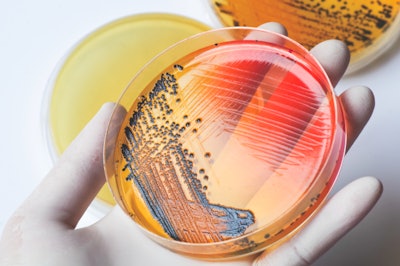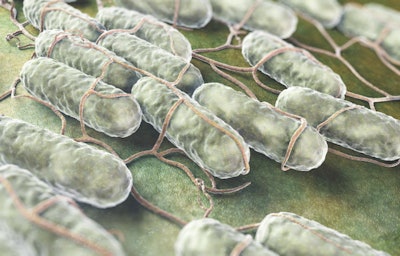
A coordinated approach is needed to reduce bacterial loads, maintain animal health
Salmonella infections are among the most common foodborne infections affecting humans. Salmonella enterica can be transmitted from feed to animals, then to human food. Animal feed ingredients — particularly animal and plant-derived protein meals — are frequently contaminated with Salmonella either from the source, the processing plant or due to recontamination in feed mills. To produce Salmonella-free feed, contamination of ingredients and/or feeds, as well as pathogen growth in the feed, need to be prevented.
Microbial hazards may be introduced into various steps of feed production and during delivery to the farm. Therefore, technologies need to both be effective at reducing levels of Salmonella, providing protection from recontamination and acting within the animals.
Feed materials contamination
It is important to consider the potential of each raw material coming into the mill to contain Salmonella. Whole grains, such as wheat and barley, are low risk as they are still encased in their natural protective layer. However, it is still important to do general quality control checks: cereals should have been dried sufficiently and should not have signs of damage, like cracked grains. And, in terms of storage, there needs to be good ventilation to prevent grains from becoming damp, which promotes microbial growth.
Ingredients like soybean, sunflower and rapeseed meals are high risk. This is because crushing, grinding or other kinds of processing have removed their natural protection. Another risk factor is that, once the seeds have been crushed and heated to 80-100 C to remove the oil, they need to be cooled. This process creates condensation and the air used may be dirty, allowing mold and bacteria to grow.
In addition, the cooked free protein, containing easily digestible amino acids, is now available to bacteria in an ideal still-warm environment. Therefore, for these kinds of products, including distillers dried grains with solubles (DDGS), the recontamination of the products after processing poses the greatest threat.
 Salmonella present in animal feed is a significant source of infection in livestock and is considered a public health hazard. (iLexx | iStock.com)
Salmonella present in animal feed is a significant source of infection in livestock and is considered a public health hazard. (iLexx | iStock.com)Feed mill hygiene
As part of their quality control process, feed manufacturers should be testing high-risk raw materials more often. It is essential to work with raw material suppliers who have the appropriate accreditation to ensure their quality standards minimize the risk of Salmonella contamination. However, the onus is on the feed producer to test and take any steps necessary to reduce the risk as the whole of the feed mill is at risk, along with all feed produced, if a contaminated raw material is bought in.
Feed can be heat treated specifically to reduce bacterial load or as part of extrusion or pelleting processes. However, following heat treatment, there is a high risk of recontamination often during cooling or drying as described for meals. For this reason, it is prudent to add an organic acid to the feed following heat treatment.
Risky areas in the mill include the mixer, storage silo, the cooler/dryer and conveyors. Therefore, as well as treating the feed, regular cleaning of the mill and equipment is essential to reduce the risk of microbial growth inside machinery.
Feed treatments
Formaldehyde has been a staple of feed pathogen control around the world for decades. However, EU Member States voted to deny the authorization of formaldehyde for use as a feed additive for control of Salmonella in feed. It was a strong, cheap and very effective product, but there were concerns over operator safety, as well as animal health and environmental concerns. In Europe in particular, feed millers and poultry producers need to completely rethink their feed hygiene strategy.
Organic acids, such as formic, propionic, acetic, fumaric, caprylic, lactic, etc., have been used as bactericides for feed and as acidifiers to improve intestinal health. The efficacy of organic acids in reducing bacteria in feed is dependent on usage rate, the initial level of bacteria, feed composition and time between treatment and feeding. The supplementation of organic acids at the right high doses in animal feed can increase the body weight, improve feed conversion ratio and reduce colonization of pathogens in the intestine. More specifically, they decrease the pH value and the buffering capacity of the feed, inhibiting the growth of gram-negative bacteria in the gastrointestinal tract.
Salmonella in the animal
In addition to organic acids, various feed and water additives have been used to reduce Salmonella colonization in the animal.
Managing gut health is key to optimizing performance, as an imbalance in the gut microflora may reduce nutrient absorption and lead to digestive upset. Prebiotics, probiotics and botanicals are often used to encourage the growth of beneficial bacterial and reduce the growth of pathogens, including Salmonella.
Novel ways to reduce levels of Salmonella in livestock, such as bacteriophages, have demonstrated positive effects.
A trial selected a number of bacteriophages isolated from poultry farms to investigate their ability to reduce Salmonellalevels in experimentally colonized broilers. One reduced S. enterica serotype Enteritidis caecal colonization by ≥4.2 log10 CFU within 24 hours compared with controls and another reduced S. enterica serotype Typhimurium by ≥2.19 log10 CFU.
Transportation and the farm
Reducing the Salmonella risk in feed doesn’t end at the mill; recontamination can also happen during transport. Quality control procedures should be linked up with the farm to ensure clean feed is delivered in clean lorries and emptied into clean silos. As well as cleaning of lorries and other equipment, using a feed treatment with residual effect helps to prevent recontamination. Also, on-farm biosecurity is paramount to reduce Salmonella levels in animals but is outside the scope of this article.
It is important to remember that the effect of contaminated feed may not end with the animal consuming it. The protection of breeding animals from Salmonella contamination plays a crucial role in preventing the vertical spread of the infection to their progeny and in keeping the supply chain safe.
Feed hygiene measures for breeding animals should be even more stringent — particularly, in the case of poultry. For this reason, producers often use additional preventative measures such as spraying chicks with a probiotic.
Integrated approach
The use of the potent treatment formaldehyde has sometimes meant that mistakes could be made and got away with. Many people believe it’s not surprising that more bacterial challenges and issues with Salmonella are currently being seen since the ban in Europe.
The microbial safety of animal feed is paramount to public health. As such, there will always be an obligation for the industry to do all it can to reduce bacterial contamination of feed. With pressure to reduce antibiotic usage and improve sustainability, feed hygiene solutions need to be effective and integrated with Salmonella control throughout the food chain. This will also give the public confidence in the animal products they are buying. Options include heat treatment and organic acids, as well as probiotics and other feed additives.
By using strategies that also improve animal health and performance, there are additional economic benefits for livestock producers in the fight against Salmonella contamination.
References available upon request.















